Top 50 Global ports in the world 2021
Date:2022-04-07
Recently, the Shanghai International Shipping Research Center released the “2021 Global Port Development Report”.The report ranks the world’s top 50 global ports in 2021 based on cargo throughput. Among the top 50 ports, China holds 28 seats (including Hong Kong, China). The Yangtze River Delta port is even more outstanding, occupying 10 seats.
| Ranking: | Country | Port | 2019 | 2020 | 2021 | 21-20 | 21-19 |
| 2021(2020) | (Million tons) | (Million tons) | (Million tons) | Growth | Growth | ||
| 1(1) – 0 | China | Ningbo, zhoushan | 111977 | 117240 | 122405 | 0.044 | 0.093 |
| 2(2) – 0 | China | Shanghai | 71677 | 71104 | 76970 | 0.082 | 0.074 |
| 3(3) – 0 | China | Tangshan | 65664 | 70260 | 72240 | 0.028 | 0.1 |
| 4(5) ↑ 1 | China | Qingdao | 57745 | 60459 | 63029 | 0.043 | 0.092 |
| 5(4) ↓ 1 | China | Guangzhou | 60633 | 61239 | 62367 | 0.018 | 0.029 |
| 6(6) – 0 | Singapore | Singapore | 62652 | 59074 | 59964 | 0.015 | -0.043 |
| 7(7) – 0 | China | Suzhou | 52272 | 55408 | 56590 | 0.021 | 0.083 |
| 8(8) – 0 | Australian | Headland | 52188 | 54705 | 55327 | 0.011 | 0.06 |
| 9(10) ↑ 1 | China | Rizhao | 46369 | 49615 | 54117 | 0.091 | 0.167 |
| 10(9) ↓ 1 | China | Tianjin | 49207 | 50290 | 52954 | 0.053 | 0.076 |
| 11(11) – 0 | Netherlands | Rotterdam | 46940 | 43681 | 46871 | 0.073 | -0.001 |
| 12(12) – 0 | Korea | Busan | 46899 | 41120 | 44252 | 0.076 | -0.056 |
| 13(13) – 0 | China | Yantai | 38622 | 39935 | 42337 | 0.06 | 0.096 |
| 14(19) ↑5 | China | Beibu Gulf | 25568 | 29567 | 35822 | 0.212 | 0.401 |
| 15(18) ↑3 | China | Taizhou | 28243 | 30111 | 35291 | 0.172 | 0.25 |
| 16(25) ↑9 | China | Jiangyin | 22393 | 24705 | 33757 | 0.366 | 0.507 |
| 17(15) ↓2 | China | Dalian | 36641 | 33401 | 31553 | -0.055 | -0.139 |
| 18(17) ↓1 | China | Huanghua | 28773 | 30125 | 31134 | 0.033 | 0.082 |
| 19(16) ↓3 | China | Nantong | 33620 | 31014 | 30851 | -0.005 | -0.082 |
| 20(20) -0 | Korea | Gwangyang | 30971 | 27332 | 29206 | 0.069 | -0.057 |
| 21(21) -0 | China | Shenzhen | 25784 | 26506 | 27838 | 0.05 | 0.08 |
| 22(24) ↑2 | China | Fuzhou | 21255 | 24897 | 27352 | 0.099 | 0.287 |
| 23(26) ↑3 | China | Lianyungang | 23455 | 24182 | 26918 | 0.113 | 0.148 |
| 24(22) ↓2 | China | Nanjing | 25689 | 25112 | 26855 | 0.069 | 0.045 |
| 25(28) ↑3 | China | Zhanjiang | 21578 | 23391 | 25555 | 0.093 | 0.184 |
| 26(30) ↑4 | Belgium | Antwerp | 23818 | 23097 | 23987 | 0.038 | 0.007 |
| 27(14) ↓14 | China | Zhenjiang | 32916 | 35064 | 23706 | -0.324 | -0.28 |
| 28(32) ↑5 | Malaysia | Kelang | 24306 | 22302 | 23543 | 0.056 | -0.031 |
| 29(27) ↓2 | China | Yingkow | 23821 | 23821 | 22997 | -0.035 | -0.035 |
| 30(29) ↓1 | Brazil | Itaqui | 22959 | 23189 | 22795 | -0.017 | -0.007 |
| 31(33) ↑2 | China | Xiamen | 21348 | 20750 | 22756 | 0.097 | 0.066 |
| 32(23) ↓9 | China | Hong Kong | 26332 | 24929 | 21373 | -0.143 | -0.188 |
| 33(31) ↓2 | America | South Louisiana | 23465 | 22721 | 20847 | -0.082 | -0.112 |
| 34(37) ↑3 | America | Los Angeles* | 20730 | 18300 | 20710 | 0.132 | -0.001 |
| 35(34) ↓1 | China | Qinhuangdao | 21877 | 20061 | 20053 | 0 | -0.083 |
| 36(41) ↑5 | China | Chongqing | 17127 | 16498 | 19804 | 0.2 | 0.156 |
| 37(38) ↑1 | America | Long Beach | 16992 | 17182 | 19639 | 0.143 | 0.156 |
| 38(35) ↓3 | China | Dongguan | 19808 | 19857 | 18896 | -0.048 | -0.046 |
| 39(36) ↓3 | Korea | Ulsan | 20238 | 18794 | 18472 | -0.017 | -0.087 |
| 40(40) -0 | Japan | Nagoya * | 19444 | 16852 | 17695 | 0.05 | -0.09 |
| 41(43) ↑2 | Vietnam | Hochiminh | – | 16324 | 16912 | 0.036 | – |
| 42(49) ↑7 | Malaysia | TANJUNG PELEPAS | 13720 | 14462 | 16806 | 0.162 | 0.225 |
| 43(42) ↓1 | Australian | Newcastle | 17042 | 16454 | 16609 | 0.009 | -0.025 |
| 44(39) ↓5 | Australian | Dampier | 17080 | 16993 | 16521 | -0.028 | -0.033 |
| 45(45) -0 | Korea | Inchon | 15774 | 15223 | 15828 | 0.04 | 0.003 |
| 46(47) ↑1 | Canada | Vancouver* | 14419 | 14550 | 15280 | 0.05 | 0.06 |
| 47(57) ↑10 | China | Jiujiang | 11358 | 12047 | 15175 | 0.26 | 0.336 |
| 48(48) – 0 | America | Cobos Christie | 11083 | 14489 | 15173 | 0.047 | 0.369 |
| 49(46) ↓3 | Brazil | Santos | 13401 | 14647 | 14701 | 0.004 | 0.097 |
| 50(44) ↓6 | China | Hangzhou | 13881 | 15414 | 14655 | -0.049 | 0.056 |
In 2021, Ningbo Zhoushan Port will maintain the world’s largest throughput of 1,224.05 million tons, and it is also the only one billion-ton port, with a year-on-year growth rate of 4.4% in 2021;
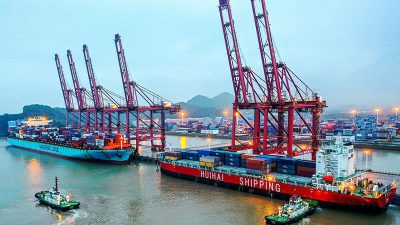
Ningbo Zhoushan Port
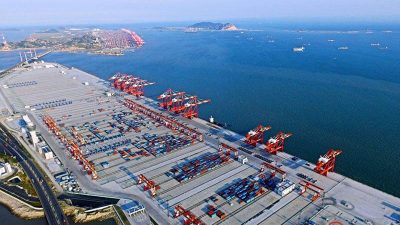
Shanghai Port
Shanghai Port and Tangshan Port ranked 2nd and 3rd with a throughput of 769.7 million tons and 722.4 million tons respectively, with a growth rate of 8.2% and 2.8% respectively;
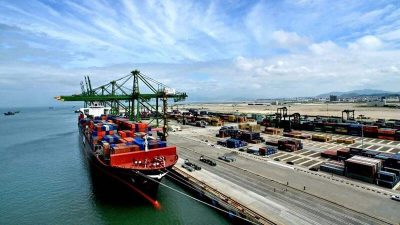
Jiangyin Port
It is worth noting that Jiangyin Port will deliver an ultra-high growth rate of 36.6% in 2021, jumping from 25th in 2020 to 16th.
Obvious advantage
The Yangtze River Delta agglomeration is located on the southeast coast, connected to the Pacific Ocean to the outside, and sits on the ecliptic of the Yangtze River internally, and has a very strong endowment.
On December 16th, last year, the 30 millionth TEU loaded and unloaded by Ningbo Zhoushan Port in 2021 was lifted at the Wisdom Wharf of Meishan Port Area. Ningbo Zhoushan Port has thus become the third 30-million-class container port in the world after Shanghai Port and Singapore Port, and the second super port in China that has exceeded 30 million TEUs since 2011. Just a few days ago, the container throughput of the Yangtze River Delta port exceeded 100 million TEUs in 2021.
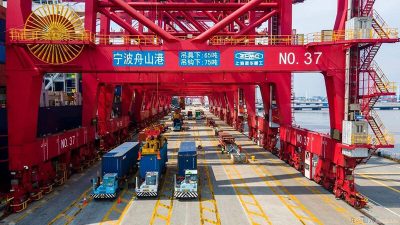
Ningbo Zhoushan Port to load and unload the 30 millionth TEU in 2021
Port throughput is an important quantitative indicator reflecting the results of port production and operation activities. The flow direction, quantity and physical classification of port throughput are the most direct manifestations of the status, role and influence of ports in international and inter-regional water transportation chains. It is also a quantitative reference for measuring the construction and development of countries, regions and cities.
As the port group with the most intensive distribution and the largest throughput of coastal ports in China, the Yangtze River Delta port group has two world-class ports of Shanghai Port and Ningbo Zhoushan Port, plus Taicang Port, Nanjing Port, Jiaxing Port, Nantong Port and other “rising stars”. It has basically formed a “body and two wings” structure with the above seaports as the core and Jiangsu and Zhejiang ports as the two wings. The 300-million-ton inland ports in Anhui Province, such as Wuhu Port, Maanshan Port and Tongling Port, also give some support to other Yangtze River Delta ports in terms of hinterland resources.
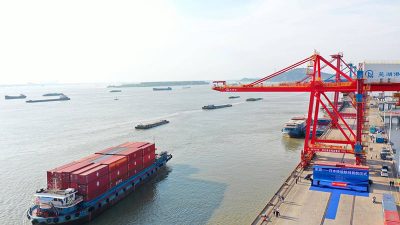
Wuhu Port
Deepen cooperation
The competition and cooperation relationship between several major ports in the Yangtze River Delta has always attracted attention from all walks of life, but in the ups and downs, resource integration and coordinated development have become a consensus and general trend. In recent years, the cooperation between ports in the Yangtze River Delta has been deepened and the scope continued to expand.
The “Outline of the Yangtze River Delta Regional Integrated Development Plan” issued and implemented in December 2019 proposed that the construction of port and waterway should be promoted in coordination.
Promote the integration of port and shipping resources, optimize the port layout, improve the integrated development mechanism, enhance the ability to serve the whole country, and form a world-class port group with reasonable division of labor and mutual cooperation.
Focusing on improving international competitiveness, strengthen the division of labor and cooperation between Shanghai, Zhejiang and Hangzhou Bay ports, deepen Shanghai-Zhejiang Yangshan development cooperation with capital as a link, make Shanghai International Shipping Center container hub port bigger and stronger, and accelerate the construction of Ningbo Zhoushan Port as a modern comprehensive port.
Strengthen the cooperation and joint development of river-sea intermodal transport of coastal and river-side ports, encourage all port groups to strengthen cooperation through cross-shareholding and other methods, and promote the coordinated development of ports in the Yangtze River Delta.
The construction of the port group has thus been raised to the height of an important part of the integration of the Yangtze River Delta.
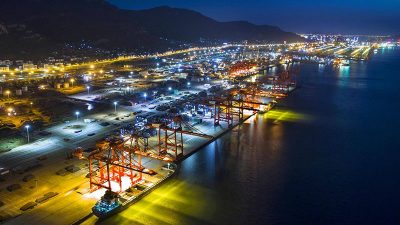
Lianyungang Port
On March 11, Lianyungang (601008) disclosed a plan for private placement of 372 million shares. It is worth noting that the target of this non-public offering is Shanghai Port Group, which subscribes in cash. As of the announcement date of the plan, SIPG has no associated relationship with the company. After the issuance, SIPG will hold more than 5% of the company’s shares.
The plan shows that: Lianyungang and SIPG will realize strategic cooperation through fixed increase. The two parties will use capital as a link to realize the strategic reorganization of port resources in the Yangtze River Delta region and promote the coordinated development of ports in the Yangtze River Delta. Taking Lianyungang Port as a cooperation platform, Shanghai Port Group is introduced as a strategic investor to integrate port assets and realize complementary advantages, so as to improve the scientific development and utilization level of port resources and help the future development of Lianyungang.
Cooperation like this isn’t the first time.
In February 2019, Shanghai International Port (Group) Co., Ltd. and Zhejiang Seaport Investment and Operation Group Co., Ltd. signed the “Xiaoyangshan Port Area Comprehensive Development Cooperation Agreement”. The two parties will jointly promote the comprehensive development of Xiaoyangshan through equity cooperation.
In December 2018, on the day of its establishment, Anhui Port and Shipping Group Co., Ltd. signed a strategic cooperation agreement with the Shanghai Port Management Committee Office, China COSCO Shipping Corporation Limited, Shanghai Port Group, and Zhejiang Seaport Group Corporation.
In mid-December 2018, the Ministry of Transport, the Shanghai Municipal People’s Government, the Jiangsu Provincial People’s Government, the Zhejiang Provincial People’s Government, and the Anhui Provincial People’s Government jointly issued the “Six Action Plans for Coordinated Promotion of the Integrated Development of Ports and Shipping in the Yangtze River Delta”, which clearly stated that thirteen major tasks of six major actions, including inland waterway networking, regional port integration, standardization of shipping vessels, coordinated development of green shipping, sharing of information resources, and linkage of shipping center construction, were completed.
Next: 14 units of Pneumatic fenders with LR inspection delivered to The United States
RELATED
- New shipment of ID500 discharge rubber hoses for dredging
- Effective Ship Anchoring: Key Steps for Stability and Safety
- Sweden Tender – Quay front reinforcement & rubber fenders replacement at Norrköping harbor
- Dia2500×L4000mm Pneumatic Fenders and GD Type Fenders to Europe
- How to Properly Store Marine Airbags for Longevity?
- Top 10 container throughput of ports worldwide in 2024
- Successful Shipment of D3.3xL6.5m Pneumatic Fenders to Southeast Asia
- Sri Lanka Tender – D type rubber fenders – 180 X 160 (Side)

